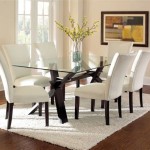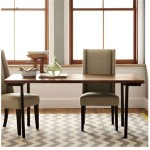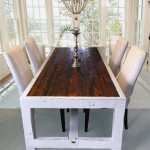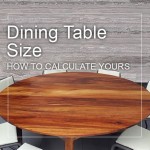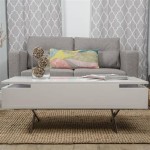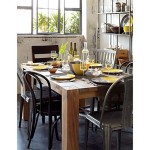Building An Outdoor Dining Table: A Comprehensive Guide
An outdoor dining table serves as the focal point for many backyard gatherings, transforming a simple patio into an inviting space for meals and social interaction. Constructing one offers a unique opportunity to customize the size, style, and materials to perfectly complement an existing outdoor aesthetic. This article provides a detailed guide on building a durable and aesthetically pleasing outdoor dining table, covering material selection, design considerations, and step-by-step construction techniques.
Selecting the Right Materials
The longevity and visual appeal of an outdoor dining table are significantly influenced by the materials chosen. Weather resistance, durability, and aesthetic compatibility with the surrounding environment are paramount considerations during the selection process. Common materials include various types of wood, metal, and composite options, each possessing unique characteristics that dictate their suitability for outdoor use.
Wood: Wood offers a classic and warm aesthetic, lending itself well to a variety of design styles. However, not all woods are created equal in terms of weather resistance. Pressure-treated lumber is a common and cost-effective option, offering resistance to rot and insect infestation. However, it is essential to understand the chemicals used in the treatment process and choose options that are safe for contact with food and people. Cedar and redwood are naturally rot-resistant and possess an attractive grain, making them desirable choices for outdoor furniture. These woods contain natural oils that protect them from the elements, but they are typically more expensive than pressure-treated lumber. Teak is another premium wood known for its exceptional durability and weather resistance. It is a dense and oily hardwood that can withstand harsh outdoor conditions without requiring frequent maintenance. However, teak is a considerably more expensive option, reflecting its superior qualities.
When selecting wood, it is imperative to choose pieces that are straight, free of excessive knots, and properly dried. Warped or twisted lumber can significantly complicate the construction process and compromise the structural integrity of the table.
Metal: Metal offers a sleek and modern aesthetic, and is known for its durability. Aluminum is a popular choice due to its lightweight nature and resistance to rust. It can be easily shaped and welded, allowing for intricate designs. Steel is another durable option, but it is susceptible to rust if not properly treated. Powder coating is a common method of protecting steel from the elements, providing a durable and attractive finish. Wrought iron is a traditional choice, offering a classic and ornate look. However, it is heavy and requires regular maintenance to prevent rust.
When working with metal, it is crucial to use appropriate welding techniques and safety equipment. Proper ventilation is essential when welding, and protective eyewear and gloves should always be worn.
Composite Materials: Composite materials, such as recycled plastic lumber or wood-plastic composites, offer a low-maintenance and environmentally friendly alternative to traditional wood. These materials are resistant to rot, insects, and moisture, making them ideal for outdoor use. They are also available in a variety of colors and textures, allowing for customization to match existing outdoor decor. However, composite materials may not possess the same natural warmth and aesthetic appeal as real wood.
When selecting composite materials, it is important to consider their UV resistance and thermal expansion properties. Some composites may fade or warp when exposed to prolonged sunlight or extreme temperature fluctuations.
Design Considerations
The design of an outdoor dining table should consider both functionality and aesthetics. The size and shape of the table should be appropriate for the intended use and the available space. The design should also complement the existing outdoor decor and reflect personal preferences. Factors such as the number of people to be seated, the style of chairs to be used, and the overall aesthetic of the outdoor space should inform the design process.
Size and Shape: The size of the table should be proportionate to the size of the outdoor space. A large table in a small patio can feel cramped and overwhelming, while a small table in a large yard may appear insignificant. Rectangular tables are a common choice, offering ample seating and a classic look. Round tables are ideal for smaller spaces, promoting conversation and creating a more intimate atmosphere. Square tables are a versatile option, suitable for both small and large gatherings. Oval tables offer a softer alternative to rectangular tables, providing a more fluid and organic shape.
The height of the table should be approximately 30 inches, which is the standard height for dining tables. This allows for comfortable seating with typical dining chairs. The width of the table should be sufficient to accommodate place settings and serving dishes. A minimum width of 36 inches is recommended for comfortable dining.
Style: The style of the table should complement the existing outdoor decor. A rustic design with rough-hewn wood and exposed joinery may be appropriate for a casual and informal setting. A modern design with clean lines and minimalist details may be more suitable for a contemporary outdoor space. The choice of materials and finishes can also significantly influence the overall style of the table. Natural wood finishes can enhance the warmth and character of the wood, while painted finishes can add a pop of color and create a more polished look.
Construction Techniques: The design should also take into account the construction techniques to be used. A simple design with straightforward joinery may be easier to build for beginners, while a more complex design with intricate details may require advanced woodworking skills. The choice of joinery techniques should also be appropriate for the materials being used. Mortise and tenon joints are a strong and durable option for connecting wood components, while screws and bolts can be used for simpler connections. Welding is a common technique for joining metal components.
When designing the table, it is helpful to create a detailed plan or drawing. This will help to visualize the finished product and identify any potential problems or challenges. The plan should include dimensions, material specifications, and a detailed breakdown of the construction process.
Step-by-Step Construction Techniques
The construction of an outdoor dining table involves several steps, from cutting and preparing the materials to assembling and finishing the table. The specific techniques used will vary depending on the design of the table and the materials being used. However, the following provides a general overview of the construction process.
Preparing the Materials: The first step is to gather all the necessary materials and tools. This includes the lumber, hardware, and finishing supplies. The lumber should be inspected for defects and cut to the appropriate dimensions according to the plan. It is important to use accurate measurements and precise cuts to ensure that the table is square and stable.
After cutting the lumber, it should be sanded smooth to remove any splinters or rough edges. This will also help to prepare the surface for finishing. The sanding process should start with a coarse grit sandpaper and gradually move to a finer grit for a smooth finish.
Assembling the Table Frame: The table frame provides the structural support for the tabletop. It typically consists of four legs connected by aprons or stretchers. The legs should be securely attached to the aprons using mortise and tenon joints, screws, or bolts. The aprons should be long enough to provide adequate support for the tabletop and wide enough to allow for comfortable legroom.
The frame should be assembled on a flat and level surface to ensure that it is square. A square can be used to check that the corners are 90 degrees. If the frame is not square, it can be adjusted by loosening the connections and re-squaring the frame.
Attaching the Tabletop: The tabletop can be made from a single piece of lumber or multiple pieces joined together. If using multiple pieces, they should be joined using glue and clamps. The glue should be applied evenly to the edges of the boards, and the boards should be clamped tightly together until the glue is dry.
The tabletop should be attached to the frame using screws or bolts. The screws or bolts should be long enough to penetrate the frame securely, but not so long that they protrude through the tabletop. The screws or bolts should be spaced evenly around the perimeter of the tabletop.
Finishing the Table: The final step is to finish the table to protect it from the elements and enhance its appearance. This typically involves applying a stain, sealant, or paint. The choice of finish will depend on the type of material being used and the desired aesthetic.
For wood, a stain can be used to enhance the natural grain and add color. A sealant, such as polyurethane or spar urethane, can be used to protect the wood from moisture and UV damage. For metal, a powder coating or paint can be used to protect the surface from rust and corrosion.
The finish should be applied according to the manufacturer's instructions. Multiple coats may be necessary to achieve the desired level of protection and appearance. It is important to allow the finish to dry completely between coats.
Final Inspection: After the finish has dried, the table should be inspected for any imperfections or defects. Any rough edges or splinters should be sanded smooth. The hardware should be checked to ensure that it is tight and secure. Once the table has passed inspection, it is ready to be used.

Rachel Schultz How To Build A 75 Outdoor Dining Table

Diy Outdoor Table Angela Marie Made

Diy Outdoor Dining Table Restoration Hardware Dupe Thrifty Pineapple
:max_bytes(150000):strip_icc()/cherishedbliss-2fe16e06a68b44589c6631e6b39ae68f.jpg?strip=all)
18 Diy Outdoor Table Plans

Diy Outdoor Dining Table

Diy Outdoor Dining Table Plan

13 Durable Diy Outdoor Dining Tables Shelterness

Building An Outdoor Dining Table Erin Kestenbaum

Diy Outdoor Dining Table Youtube

Create An Outdoor Dining Area On A Budget


